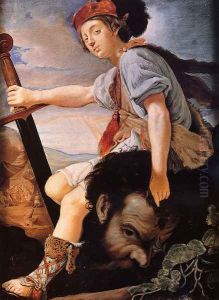T. Flatman Paintings
Thomas Flatman was an English poet, miniature painter, and lawyer, born in 1637 in Aldersgate, London. He was the son of a clerk at the King's Bench, which likely influenced his initial career path towards law. Flatman was educated at Winchester College and went on to attend New College, Oxford, in 1652, although he left without obtaining a degree. Despite his legal training and being called to the bar at the Inner Temple in 1658, Flatman's passion lay in the arts, particularly poetry and miniature painting, which ultimately defined his career and legacy.
Flatman's literary career began to flourish in the 1650s and 1660s, with his poems reflecting the political and social upheavals of the time. He published his first collection of poems, 'Poems and Songs,' in 1674, which included one of his most famous works, 'An Appeal to Cats in the Business of Love.' His poetry, often characterized by its wit and elegance, captured the complexities of Restoration England, navigating both the celebratory and the melancholic. Flatman was also known for his elegies, which commemorated figures such as the poet Abraham Cowley and the statesman Anthony Ashley Cooper, Earl of Shaftesbury.
As a painter, Flatman achieved considerable renown for his miniatures, which were highly sought after by the gentry and nobility of his time. His style was detailed and expressive, contributing significantly to the art of miniature painting in the 17th century. Flatman's clientele included several notable figures, and his works were celebrated for their delicate precision and depth of character. Despite the lack of extensive surviving work, his contributions to the art form have been acknowledged by art historians as significant.
Thomas Flatman's dual career as a poet and painter placed him at the heart of the vibrant cultural life of Restoration England. His work, both literary and artistic, reflects the complexities and contradictions of the period, capturing its essence in verse and on vellum. Flatman died in 1688, leaving behind a legacy that, though not as widely remembered today, offers valuable insight into the artistic and cultural milieu of his time.
